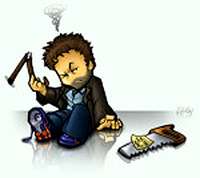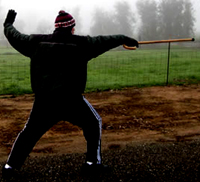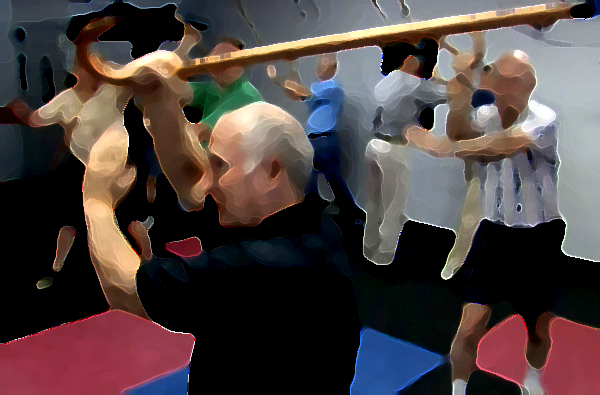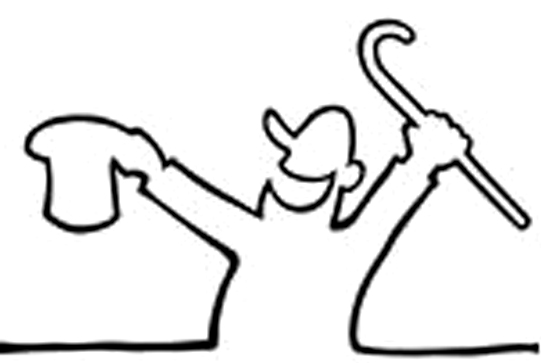The Cane and I
“A legend is an old man with a cane known for what he used to do.
I’m still doing it.”
-Miles Davis
I was irresponsible, had the wrong priorities, moving too fast and not thinking things through. Thus I slipped as my bare, wet feet met my tile foyer. There was a sound like tearing wet jeans. There was pain and the total certainty that I had just broken my foot.
Turns out, no, I had only torn the ligaments of my foot. An injury which, they told me during three hours at the ER, hurts just as bad but heals quicker. Still, not fast enough, as I pen this nearly a month later and glance at my cane.
The cane. The doctor wanted me in bed for a week. Not possible. On crutches, then. Not possible. I chose the cane. I didn’t know it at the time, but that choice, and this injury has brought me closer to my patients than any other life experience.
The cane, you see, is my Residential Treatment Facility. It’s my Rehab. It’s my outpatient. It’s my therapy. And I hate it.
According to a Surgeon General report “Today, the majority of those who need mental health treatment do not seek it” despite the overwhelming data that “appropriate treatment can alleviate, if not cure, the symptoms and associated disability of mental illness. With proper treatment, the majority of people with mental illness can return to productive and engaging lives.”
So, why? Why avoid treatment if “mental illnesses exact a staggering toll on millions of individuals, as well as on their families and communities and our Nation as a whole” like the Surgeon Genny says?
Now I know.
Stigma not Stick-ma
 I’ve said it—“The stigma of having a mental health disorder”—but I never lived it. Though I still don’t suffer from mental illness, I’m now the guy with the cane. Sure, most people are kind to me, or curious what happened. But inside I wonder. Do I look old, to them? Are they judging me because I’m overweight and out of shape? Are they thinking “Poor Keith?”
I’ve said it—“The stigma of having a mental health disorder”—but I never lived it. Though I still don’t suffer from mental illness, I’m now the guy with the cane. Sure, most people are kind to me, or curious what happened. But inside I wonder. Do I look old, to them? Are they judging me because I’m overweight and out of shape? Are they thinking “Poor Keith?”
I’ve learned to push those thoughts aside and, quite literally, just keep moving. Those stairs aren’t going to climb themselves. Still, it’s just a cane. To have depression, anxiety, social phobia, an eating disorder and have to deal with stigma must be like being treated for a gunshot wound and having the doctor hand your assailant a shotgun.
The Patience of Patients
“Healing takes courage, and we all have courage,
even if we have to dig a little to find it.”
-Tori Amos
 I’ve worked with a kid who could only say, to the reasons which brought him to therapy, “It’s not fair—I should have been out by now!” Then he would cry. He grew to be able to very calmly say “I’m frustrated that this process takes so long.” I would empathize. I would process the depth of that statement with him and praise his new born ability to articulate. I wasn’t wrong, but I didn’t get it.
I’ve worked with a kid who could only say, to the reasons which brought him to therapy, “It’s not fair—I should have been out by now!” Then he would cry. He grew to be able to very calmly say “I’m frustrated that this process takes so long.” I would empathize. I would process the depth of that statement with him and praise his new born ability to articulate. I wasn’t wrong, but I didn’t get it.
The healing process always seems like a joy to me. Watching a patient adapt, applauding the small changes, sharing accomplishment. That’s because I wasn’t inside it. Healing from my leg injury is an exhausting, sweaty, frustrating exercise in humility, patience and adaption while always pushing to the next hurdle. It is a drain on my healthy emotional and cognitive reserves; to do so without those reserves is truly a heroic effort.
I want it healed now. I want my cane gone now. So I push myself. There’s a high probability that pushing myself is what helped me to injure my back, washing my face this weekend and miss two days of work. Much like my patients, I have felt the sting of pushing too far, too fast.
A Double-Edged Cane
“Wisdom is nothing more than healed pain.”
-Robert Gary Lee, Baptist Preacher
The worst part is that it’s not all bad. I get to park in handicapped spots. Sometimes, I dance a little jig to make people laugh. I hook the handle around doorknobs to pull doors shut from a distance. I use a similar technique to pick up clothes from the floor, turn off light switches and turn on the dishwasher. Those who know me also know that I will make a toy of anything I touch, and now I have one all the time. All the former is besides the overwhelming positive benefit; It let’s me walk when I would only be able to in extreme pain.
This cane is support, reliability, structure and safety. Just like a hospital for mental illness. It can be kind of fun. Just like the hospital which I am at now. Incidentally, I am utterly grateful that Foundations integrates healthy fun into their curriculum. I’ve worked at places which have a more condemning, solemn air, and, though well-intentioned, it is unkind.
Eventually, I will say goodbye to this cane. I long for that day as I contemplate the stilted, groaning moment that will come when I use it to lever myself from this chair. But, in some ways, it will be like giving up a part of myself. Like saying goodbye to a stern friend, though the relationship only lasted months. I work with some kids who’ve spent years loving and hating but knowing and feeling safe in the hospital. The twinge in my heart, the slight tearing in two, must be wrenching in theirs. We, as service providers, celebrate a successful discharge—I know I do. Perhaps I should spend a bit more time grieving the loss of support as well.
“The health of the American people demands that we act with resolve and a sense of urgency to place mental health as a cornerstone of health,” sayeth the Surgeon General, “and address through research and education both the impact and the stigma attached to mental illness.” I believe the General to be correct. I think acting with “resolve and a sense of urgency” is awesome.
I would add “And we will begin by passing out canes.”
K


